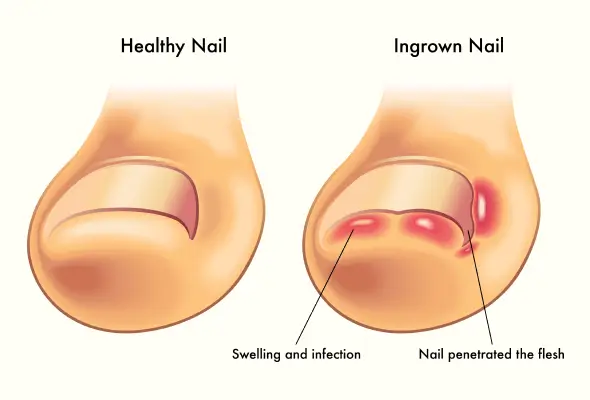-
Doctors
-
Specialities & Treatments
Centre of Excellence
Specialties
Treatments and Procedures
Hospitals & Directions HyderabadCARE Hospitals, Banjara Hills CARE Outpatient Centre, Banjara Hills CARE Hospitals, HITEC City CARE Hospitals, Nampally Gurunanak CARE Hospitals, Musheerabad CARE Hospitals Outpatient Centre, HITEC City CARE Hospitals, Malakpet
HyderabadCARE Hospitals, Banjara Hills CARE Outpatient Centre, Banjara Hills CARE Hospitals, HITEC City CARE Hospitals, Nampally Gurunanak CARE Hospitals, Musheerabad CARE Hospitals Outpatient Centre, HITEC City CARE Hospitals, Malakpet Raipur
Raipur
 Bhubaneswar
Bhubaneswar Visakhapatnam
Visakhapatnam
 Nagpur
Nagpur
 Indore
Indore
 Chh. Sambhajinagar
Chh. SambhajinagarClinics & Medical Centers
Book an AppointmentContact Us
Online Lab Reports
Book an Appointment
Consult Super-Specialist Doctors at CARE Hospitals

Ingrown Toenail
Symptom, Causes, Diagnosis and Treatment
Ingrown Toenail
Have you ever experienced the throbbing pain of an ingrown toenail? This common foot problem affects millions worldwide, causing discomfort and sometimes leading to more severe complications. An ingrown toenail happens when the nail's edge grows and penetrates the surrounding skin, resulting in inflammation, pain, and potential infection.
Understanding the causes, symptoms & treatment methods for ingrown toenails is crucial for managing this condition effectively. This article explores the signs to watch out for, discusses home remedies and medical treatments, and provides tips to prevent this painful condition. By learning about ingrown toenails, you'll be better equipped to care for your feet and seek help when needed.

What is an Ingrown Toenail?
An ingrown toenail, is a common and often painful foot condition. When your nail's edge grows into the surrounding skin, causing inflammation and discomfort. This condition most frequently affects the big toe, although it can develop on any toe. Ingrown toenails are particularly common among teenagers and young adults, possibly due to increased foot perspiration. If left untreated, an ingrown toenail can be a reason for considerable pain, disability, and complications.
Symptoms of Ingrown Toenail
Ingrown toenails typically develop in stages, with symptoms worsening over time.
- In the early stages, individuals may notice tenderness, swelling, the skin next to the nail. Pain often occurs when pressure is applied to the affected toe.
- The surrounding skin may become red as the condition progresses, and fluid might build up around the toe.
- If an infection sets in, more severe symptoms can arise. These include:
- Increased pain
- Warmth in the affected area
- A foul odour from the toe
- Pus may ooze from the site
- The skin around the ingrown toenail may become dark, and tissue may overgrow near the nail edge.
- Monitoring these symptoms is crucial, as early detection and treatment can prevent complications and alleviate discomfort associated with ingrown toenails.

Causes of Ingrown Toenail
Various factors contribute to its development, including improper nail trimming, tight footwear, and genetic predisposition.
The following are some common factors contributing to the development of ingrown toenails:
- Improper nail trimming is a common cause, as cutting toenails too short or rounding the nail's edges can cause nails to grow into the surrounding skin.
- Poor fitting of the shoes (too tight or with narrow toe boxes) puts pressure on the toes & increases the risk of ingrown toenails.
- Trauma or injury to the toe (stubbing or falling of an object on the toe) can cause abnormal nail growth.
- Certain medical conditions, like hyperhidrosis (excessive sweating), can soften the skin around the toenail, making it more susceptible to nail penetration.
- Genetic predisposition also plays a role, as people who inherit poor nail shapes or structures are more prone to becoming ingrown.
- Repeated activities (kicking a soccer ball) can contribute to the development of ingrown toenails.
Diagnosis of Ingrown Toenail
Diagnosing an ingrown toenail is typically straightforward and based on clinical features.
- Physical Assessment: Doctors, identify the condition through a physical examination. They inspect the affected toe, looking for signs such as swelling, tenderness, redness, and pain upon light touch. The skin around the nail may appear different from other toes, potentially growing over the nail edge.
- Additional Tests: In most cases, no additional tests are necessary. However, if severe infection is suspected, doctors take a discharge or nail tissue sample for bacterial or fungal culture tests. X-rays are rarely needed but may be used to assess the depth of nail growth into the skin or to rule out other conditions like subungual exostosis.
The severity of an ingrown toenail is often classified into three stages, ranging from mild inflammation to chronic infection with granulation tissue formation. This staging helps guide appropriate treatment strategies.
Treatment For Ingrown Toenail
Ingrown toenail treatment can help prevent infection and alleviate discomfort. Mild cases often respond well to home remedies, whilst more severe instances may require medical intervention. Treatment includes:
- Home Care: Soaking the affected foot in warm water for up to 20 minutes can reduce swelling and ease pain. Massaging the side where the skin meets the nail can help reduce inflammation.
- Antibiotics: In case of infection, a doctor may recommend topical or oral antibiotics to treat ingrowths.
- Non-invasive Intervention: Sometimes, a doctor may recommend lifting the nail edge and placing cotton or dental floss underneath to separate the edge from the skin. This approach helps the nail grow above the skin edge, usually within 2 to 12 weeks.
- Surgical approach: For recurrent or severe cases, a doctor may remove the affected part of the nail or the entire nail to relieve pressure and allow it to grow correctly. After a full ingrown toenail removal procedure, doctors treat the underlying nail bed to prevent regrowth.
When to See a Doctor
While home remedies often help with ingrown toenails, there are times when professional medical attention becomes necessary, such as:
- If symptoms worsen or don't improve after several days of at-home treatment
- Consulting a doctor is especially important for individuals with diabetes or circulation issues
- Signs that indicate doctor consultation include unbearable pain, visible infection, pus or liquid drainage, increased redness or swelling, warmth in the affected area, or a foul odour emanating from the toe.
- If the ingrown toenail causes difficulty walking or recurring issues, scheduling an appointment with a podiatrist is advisable.
Preventing Ingrown Toenails
Nail care tips to prevent ingrown toenails are:
- Trim toenails straight across, avoiding rounded corners.
- Soak feet in warm water before cutting to soften nails.
- Use clean nail trimmers and avoid tearing or ripping nails.
- Wearing well-fitted shoes is crucial.
- Moisture-wicking socks can keep feet dry and prevent nail softening.
- Regular foot checks are essential, especially for those prone to ingrown toenails or diabetes.
- Avoid repetitive trauma to nail sides, such as from ill-fitting shoes or excessive physical activity.
Conclusion
Ingrown toenails can significantly impact daily life, causing discomfort and potential complications if left untreated. Understanding the causes, symptoms and treatment options of ingrown toenails empowers individuals to take proactive steps in managing this common foot condition. Simple preventive measures can go a long way in reducing the risk of developing ingrown toenails, from proper nail-trimming techniques to choosing appropriate footwear.
Early detection and prompt action are key to prevent the problem from worsening. By staying informed and attentive to foot health, people can minimise the pain and inconvenience associated with ingrown toenails, ensuring comfortable and healthy feet for years to come.
FAQ's
1. Who can have an ingrown toenail?
Anyone can develop an ingrown toenail, but it's more common in teenagers and young adults. People with sweaty feet, those who wear tight shoes, or individuals who trim their nails improperly are at higher risk.
2. How common are ingrown toenails?
Ingrown toenails are quite common, affecting millions of people worldwide. They often occur in the big toe but can develop on any toe.
3. Does an ingrown toenail go away by itself?
Mild cases may resolve on their own with proper care. However, more severe cases typically require treatment to prevent complications.
4. What are ingrown toenails caused by?
Ingrown toenails can result from improper nail trimming, tight shoes, injury, or genetic predisposition. Activities like kicking a football may also contribute to their development.
5. Do ingrown toenails go away naturally?
Some mild cases may improve with home care, but many require treatment to resolve fully.
To Book an Appointment, call:
Still Have a Question?




